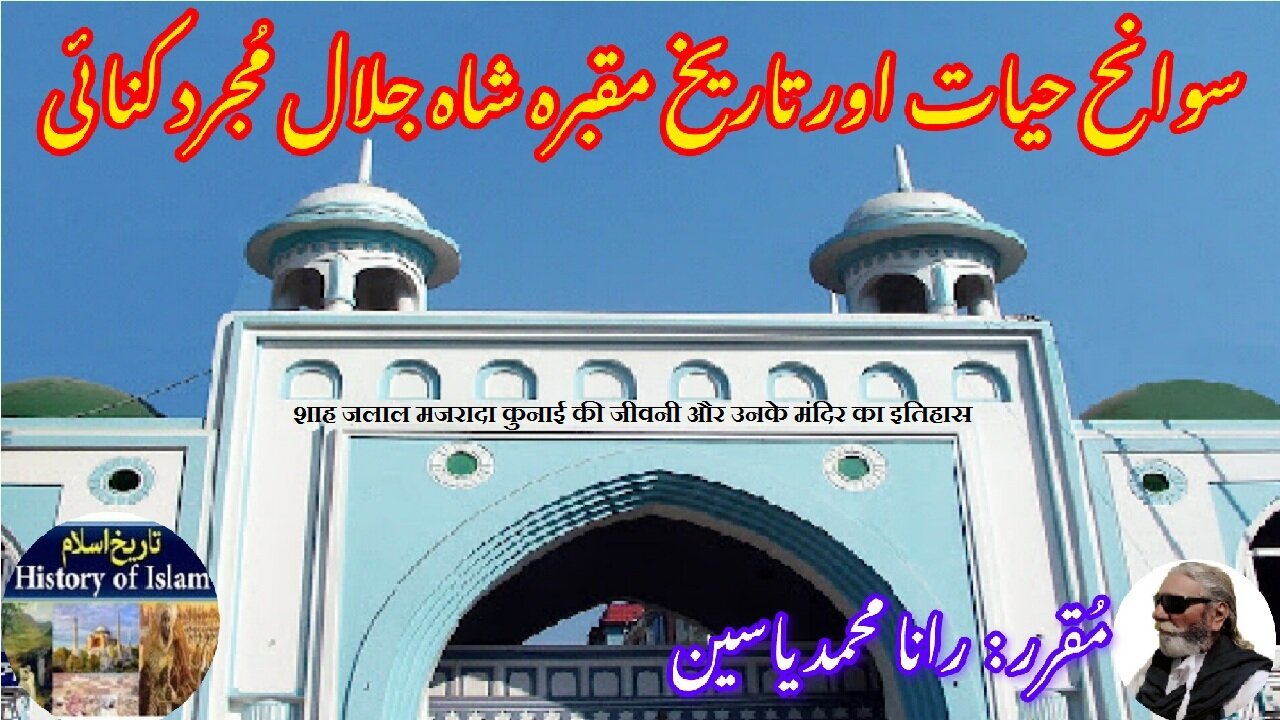Premium Only Content

Shah Jalal Majrad Kunai and his shrine شاہ جلال مجرد کنائی کی سوانح حیات اور ان کے مزار کی تاریخ
@islamichistory813 #shah #jalal #mujarrad #kunyai #sufisaint #cultural #heritage #biography #islamic #mysticism #islamic #philosophy #shrine #historical #figures
Biography of Shah Jalal Mujarrad Kunyai and the history of his shrine
Dekhti Aankhooon aur sountay kaanoon ko Asslamoalaikum, sisters, brothers friends and elders, in informative series videos of Islamic ascolars, sufisaints, cultural heritages, islamic philosophys, islamic mysticisms and historical figures. today we are describing biography of Shah Jalal Mujarrad Kunyai and the history of his shrine.
Shah Jalal Mujarrad Kunyai, popularly known as Shah Jalal, is one of the most celebrated Sufi saints in the history of Bengal, and his legacy continues to shape the religious and cultural identity of present-day Bangladesh. Born in the early 14th century, possibly around 1271 CE, in Turkestan or Yemen (as accounts vary), Shah Jalal was a descendant of the Prophet Muhammad through his maternal line and was raised in a deeply spiritual environment. Trained in Islamic theology, spiritual discipline, and mysticism, he set out on a journey across the Muslim world to spread the message of Islam. His travels eventually brought him to the Indian subcontinent, where he is most notably associated with the Muslim conquest and subsequent Islamization of Sylhet, a northeastern region of what is now Bangladesh.
Shah Jalal arrived in Sylhet around 1303 CE during the reign of Sultan Shamsuddin Firoz Shah of Bengal. At that time, the region was ruled by a Hindu king named Gour Govinda, who was known for his hostility toward Muslims. Shah Jalal joined forces with the Muslim general Syed Nasiruddin and played a pivotal role in the battle to liberate Sylhet from the oppressive regime. The victory led to the establishment of Muslim rule in the area and laid the foundation for the widespread acceptance of Islam among the local population. Following the conquest, Shah Jalal chose to settle in Sylhet permanently, where he continued to preach, guide, and inspire generations through his teachings and personal example. His simplicity, piety, and spiritual insight attracted thousands of followers, and he became widely revered not just as a conqueror, but as a saint and a guide.
Shah Jalal passed away in 1346 CE in Sylhet, where he had spent the final decades of his life in spiritual retreat and community leadership. His death marked the end of a transformative era in the religious history of Bengal. After his passing, his disciples and followers took the initiative to construct a shrine over his grave to honor his memory and preserve his legacy. The *shrine of Shah Jalal* is located in the city of Sylhet, near the present-day Shahjalal Mazar Sharif area, and it remains one of the most visited pilgrimage sites in Bangladesh. It attracts not only Muslims but also people of other faiths who come to pay their respects to the saint known for his inclusive spiritual philosophy and his role in shaping the region’s identity.
The shrine complex was initially modest, built shortly after Shah Jalal’s death by his close disciples and early devotees. As his fame grew and the number of followers increased, the shrine underwent several phases of development and expansion. Local rulers, influential families, and later colonial administrators all contributed to the upkeep and enhancement of the complex. The shrine that stands today is a blend of historical and modern architecture, incorporating elements of Islamic design with regional styles. It includes the saint’s tomb, prayer halls, courtyards, and accommodations for pilgrims. The site also houses the graves of some of Shah Jalal’s closest companions, who were instrumental in spreading Islam throughout northeastern Bengal.
One of the most notable features associated with the shrine is the large tank or pond nearby, which is home to a unique breed of large catfish that are considered sacred by the local population. Pilgrims often feed the fish as part of their devotional offerings. The *Urs* (death anniversary) of Shah Jalal is observed annually and draws tens of thousands of visitors from across Bangladesh and beyond. It is marked by special prayers, Qur’anic recitations, Sufi music, and communal gatherings that celebrate the saint’s life and teachings.
Shah Jalal’s impact is far-reaching, as seen in the many institutions and landmarks named after him. The Hazrat Shah Jalal International Airport in Dhaka, the Shah Jalal University of Science and Technology (SUST) in Sylhet, and countless mosques, schools, and roads throughout Bangladesh and even in diaspora communities, particularly in the United Kingdom, bear his name. His shrine is not only a religious monument but also a cultural and historical symbol of Bangladesh’s rich Sufi heritage.
In summary, Shah Jalal passed away in 1346 CE and was buried in Sylhet, where his shrine continues to serve as a center of spiritual devotion, historical memory, and communal harmony. Constructed by his disciples and continually supported by generations of followers, the shrine remains one of the most sacred sites in the region. Shah Jalal's enduring legacy as a spiritual leader, a warrior-saint, and a cultural icon reflects his extraordinary life and the profound influence he had on the spiritual landscape of Bengal.
With this, we seek your permission until tomorrow, tomorrow we will describe the biography of Shah Jalal Dakhini and the history of his Shrine.
Allah Hafiz
==============================
-
 12:22
12:22
ISLAMIC HISTORY
16 hours agoKhalid bin Walid (RA) Islamic Warrior Episode 63 خالد بن ولید رضی اللہ عنہ اسلامی جنگجو قسط نمبر
1 -
 LIVE
LIVE
I_Came_With_Fire_Podcast
10 hours agoPete Hegseth and the Chamber of Standards | Digital IDs | Taiwan Chips & Salsa | CDL Crisis
163 watching -
 LIVE
LIVE
Adam Does Movies
10 hours agoTalking Movies + Ask Me Anything - LIVE
28 watching -
 29:11
29:11
Nick Shirley
2 hours ago $0.14 earnedPortland has Fallen... ANTIFA Take Control of City
1475 -
 1:19:00
1:19:00
VapinGamers
2 hours agoJump Space - We All Scream in Space - Early Access - !rumbot !music
63 -
 LIVE
LIVE
Joker Effect
1 hour ago(Kick) Streamers Have Ruined The Streaming Landscape and Here is How! Reviewing Phase Partners...
522 watching -
 3:46:40
3:46:40
The Blood Lust Gaming
3 hours agoClair Obscur: Expedition 33 - LVL 1 challenge run pt.3
37 -
 2:11:38
2:11:38
Nikko Ortiz
3 hours agoPTSD Is Fun Sometimes | Rumble LIVE
9.35K1 -
 1:02:40
1:02:40
BonginoReport
4 hours agoA Florida Man Attempts a Jussie Smollett Hoax - Nightly Scroll with Hayley (Ep. 146)
118K61 -
 LIVE
LIVE
XxXAztecwarrior
3 hours agoNew Season/ New missions/Delta Force
56 watching